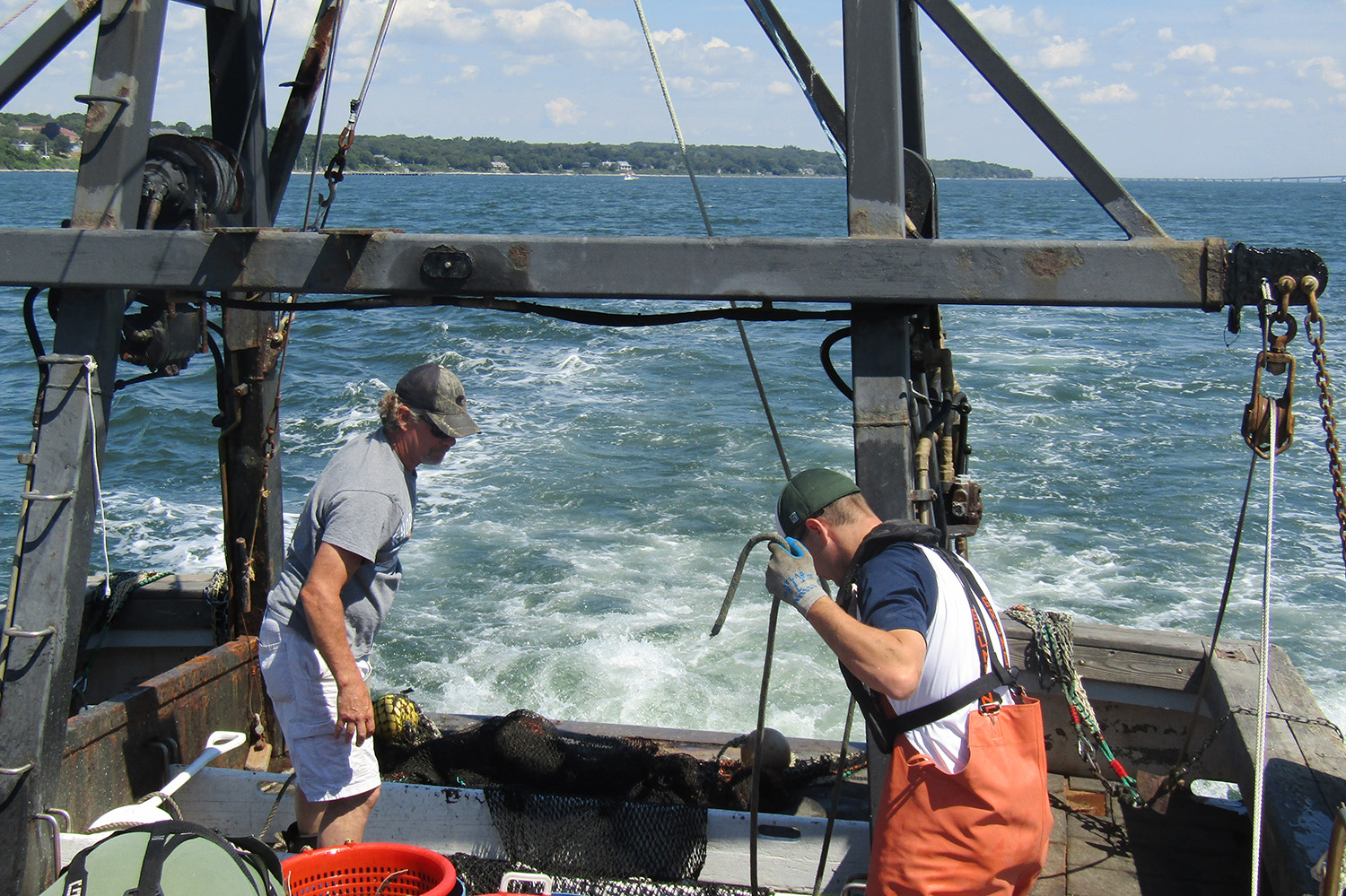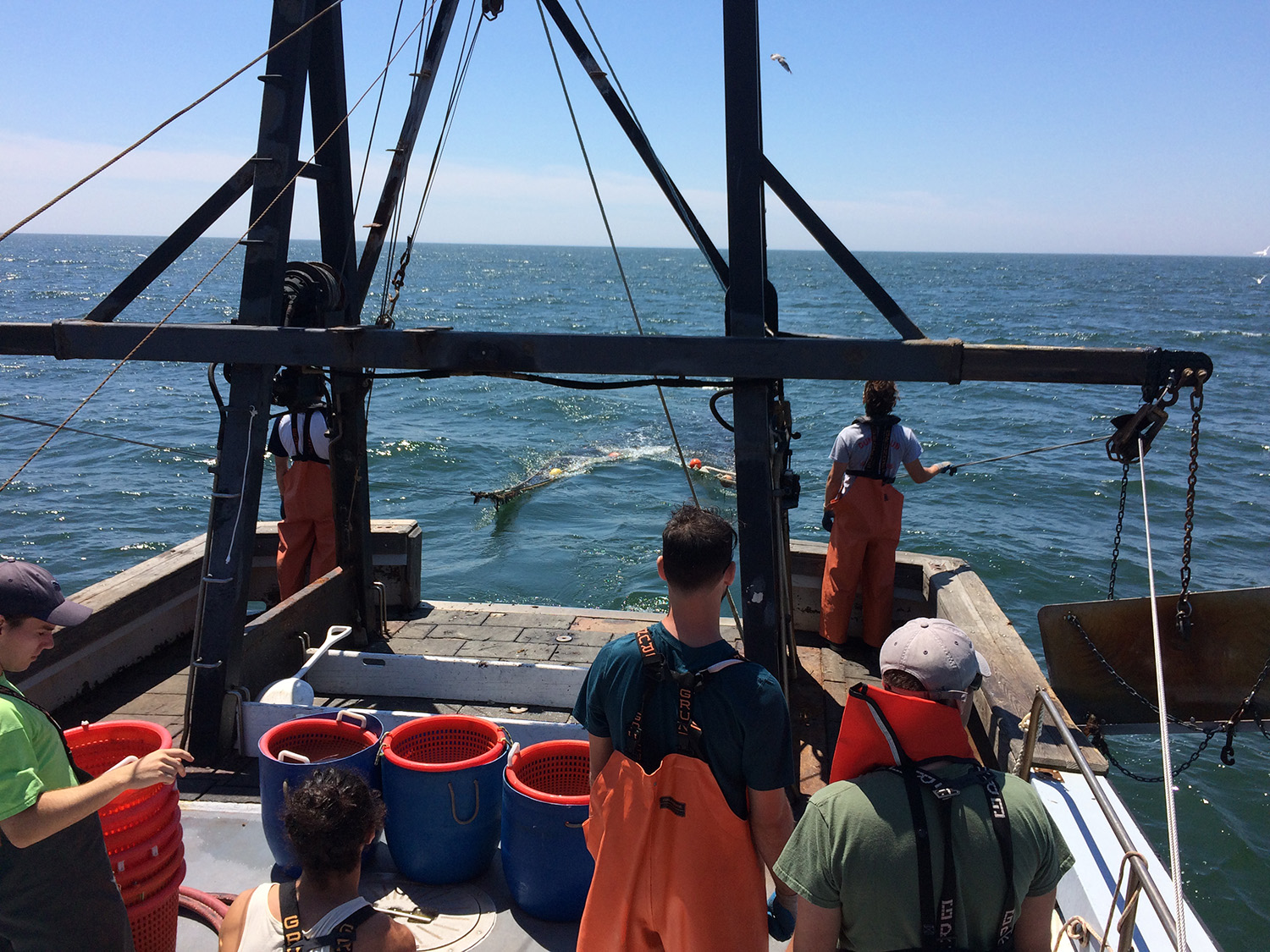

a tiny squid gets measured and counted like all the rest of the Bay’s creatures
At 9:06, Captain Steve Barber calmly spoke to the crew of five students and a professor, “If someone should go overboard…” Good captains always have a backup plan. Returning from an early morning plankton tow, he was ready for a return trip. Gear stowed, scientific equipment positioned, coffees secured and life jackets handed out, Captain Barber easily steered her through a busy Wickford Harbor. An experienced offshore commercial fisherman; his years fishing offshore on the F/V Enterprise and other boats, his calm and ease at the wheel made him a natural choice to run the Cap’n Bert.
We steamed east then south in calm seas and fair winds before Captain Barber eased back the throttle so Joe could deploy a Quality Sonde data logger for capturing temperature and salinity levels at several water column depths, meter by meter.

Captain Steve Barber
The water was 71.3 F at the surface and 65.2 on the bottom where there was about half the amount of oxygen. Accurate data helps scientists observe changes, consistencies, even abnormalities in this dynamic estuary. At 9:41, the net was paid out, doors were deployed. Thirty minutes at two knots for a distance of one nautical mile. “This is the longest continuous survey tow of its kind in the country,” Zottoli said and it may be the second oldest in the world.

Joe Zottoli lowers a data logger
Since 1959, the University has been working the same two ranges in Narragansett Bay at the same speed with the same size net. The otter trawl’s forty foot sweep is meant to work along the bottom, capturing fish and invertebrates so students and scientists can measure, observe, quantify and hypothesize.

Brown University’s Dr. Peter Belenky starts removing tissue samples aboard the Cap’n Bert
While we towed, Brown University’s Peter Belenky, Ph.D., Assistant Professor of Molecular Microbiology and Immunology, prepared to take fish gut samples. He and research assistant Benjamin Korry would later carefully remove 21 intestinal tissue samples from several different species for lab analysis where Dr. Belenky is investigating bacterial resistance to antibiotics. He’s studying whether some fish species may hold genes already coded for resistance; his work is the first of its kind.
“We’re now seeing warm water species and invertebrates, it used to be more cold water fishes,” Zottoli said. 
Pushing aside his clipboard, Zottoli smiled and said, “I’m always either cleaning or fixing something.” In addition to running the deck, he was sexing flatfish. Carefully running his fingers through a fluke he deftly sliced open, he turned aside elongated lines of ovaries, tan male testes and strands of intestines. Butterfish, Nature’s perfect little fish, flipped all over the deck before being counted and released. He noted that 92% of legal sized fluke captured last year were females, that fluke seemed to be staying longer in the bay and that since the survey began, waters had warmed two degrees centigrade.

Preparing to haul back in Narragansett Bay
The second tow went in at 11:24 just east of Narragansett beach. Thirty minutes at two knots.
[wpvideo 65nLQAdX]
Commercial draggers towed steamed nearby and Captain Barber knew them all. Sometimes the cod end comes aboard jammed tight, some winter time tows come up empty but all information is important. “Hang on guys, I’m going to turn downwind,” came the call from the wheelhouse as the crew prepared to sort a haul of lobster, menhaden, squid, sand flounders and a few oyster toadfish.

Captain Steve clears the net before the cod end is unloaded
This is steady, exacting work aboard the Cap’n Bert, producing consistent data of temperatures and fluctuations of species, both critical for local and global scientists. Politics and politicians ebb and flow, the current administration can delete science from their own websites, arguments of climate change, the health of fisheries or potential best management practices can fuel beer sales for decades but it is science, itself fueled by consistent data and a scientists love of discovery, which ultimately will prove where we are and where we are headed. For 58 years, the Cap’n Bert has steamed through Narragansett Bay, bringing home all that data.
Marine biology Nick Mongeau paused from scrubbing the deck to say, “The best part of going out on this boat is not knowing what we’re going to catch.”







0 Comments